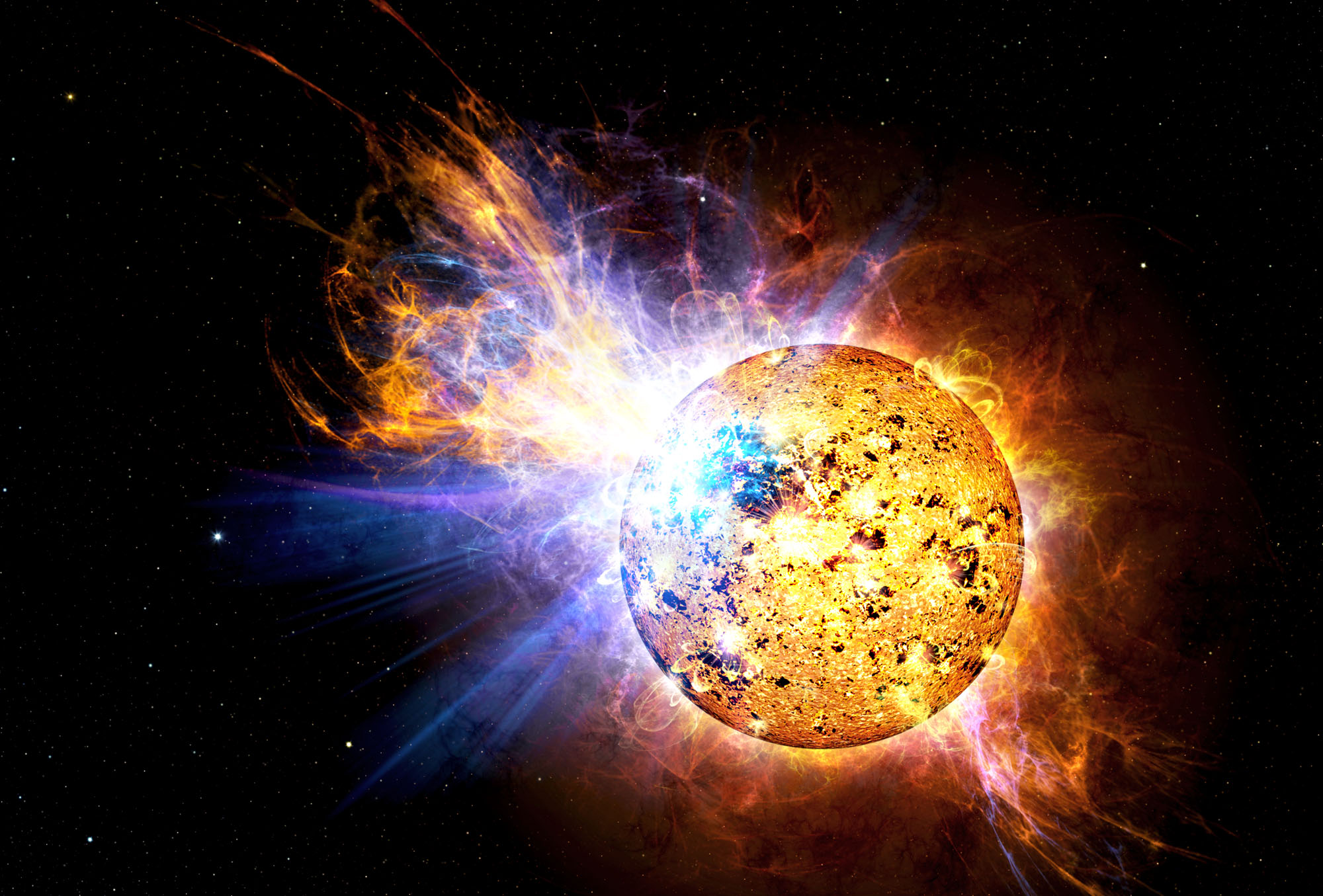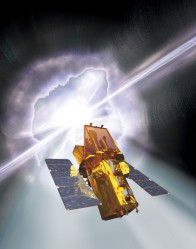NASA’s Swift satellite picked up one of the brightest solar flares ever seen — not from our own sun, but a star 16 light-years away. This flare packed the power of thousands of solar flares combined, and a flare of this magnitude from our own sun would have stripped Earth’s atmosphere and sterilized the planet. Astronomers say the flare would have been visible to the naked eye on April 25, 2008 if the star had been easily observable in the night sky at the time. As it was, the flare’s brightness caused Swifts’ Ultraviolet/Optical Telescope to shut down for safety reasons. But Swift was able to study the flare for over 8 hours with its X-ray capabilities.
The Swift satellite normally searches for gamma ray bursts, and is surrounded with detectors that look for bursts of light. The spacecraft then “swiftly” and autonomously re-points itself to the location of the burst. However, this was no gamma ray burst, just a solar flare. But what a solar flare!
The star, EV Lacertae, is a basic red dwarf, the most common type of star in the universe. It shines with only one percent of the Sun’s light, and contains only a third of the Sun’s mass. It’s one of our closest stellar neighbors, but normally is not visible with the naked eye, as it holds a magnitude of -10.
“Here’s a small, cool star that shot off a monster flare. This star has a record of producing flares, but this one takes the cake,” says Rachel Osten, from NASA’s Goddard Space Flight Center. “Flares like this would deplete the atmospheres of life-bearing planets, sterilizing their surfaces.”
Astronomers say EV Lacertae is like an unruly child that throws frequent temper tantrums. It’s a relatively young star at a few hundred million years of age. But it’s a fast rotating star which generates a strong magnetic field, about 100 times as magnetically powerful as the Sun’s field. The energy stored in its magnetic field powers these giant flares.
The flare’s incredible brightness enabled Swift to make detailed measurements in X-ray, as the star remained bright in x-rays for about 8 hours. “This gives us a golden opportunity to study a stellar flare on a second-by-second basis to see how it evolved,” says Stephen Drake of NASA Goddard.
Flares release energy across the electromagnetic spectrum, but the extremely high gas temperatures produced by flares can only be studied with high-energy telescopes like those on Swift. Swift’s wide field and rapid repointing capabilities, designed to study gamma-ray bursts, make it ideal for studying stellar flares. Most other X-ray observatories have studied this star and others like it, but they have to be extremely lucky to catch and study powerful flares due to their much smaller fields of view.
Original News Source: NASA



Incredible and amazing.
wow! what an amazing photo! (perhaps a disclaimer should read below all these images on UT.com saying if they’re computer generated or not).
That’s not a photo. It’s an artist’s depiction.
(So far as I know, all stars but the Sun are too far away for us to even resolve a disk while looking at them, much less get any sort of surface detail.)
Nat, no really?! Duh. 🙂
If you mouse over the picture it gives credit and says it’s a artists depiction.
truly amazing
Still, I’ve always hoped UT would start putting captions on the photos to indicate if they are artist renditions or what observatory took the photograph with what size telescope, what colors represent what wavelengths, etc.
Anyone know what magnitude in brightness this outburst reached?
@Nat
Not entirely true, astronomers have resolved nearby giant stars to disks, such as Betelgeuse and Altair.
@Qev
Ya, I seem to have remembered hearing about that a while back. Thanks for the info.
“It’s one of our closest stellar neighbors, but normally is not visible with the naked eye, as it holds a magnitude of -10.”
Shouldn’t that be 10 (and not -10)?
Or was this absolute magnitude (and I’m missing something else)?
it was right here in the UT forum where it was explained to me that it is not likely for life to evolve around red dwarfs due to the small size of the habitable zone and their tendency to produce deadly flares. well, what an example!
thanks UT
p.s. i would have thought it obvious that the picture is an artist’s rendition.
it is obviously an artists rendering. was being sarcastic. however cool it would be to image a star in such detail and have it’s resolution look like this one, i realize it would be highly impossible in our lifetimes. still, i think captions below the photos, not just as a rollover, would be a nice improvement to UT. And for the record, Nancy, the article’s content is fascinating to say the least.
The way you have the magnitude is wrong or at least worded badly. At magnitude “-10” this star would be easily visible at just about all times (only the Moon and Sun are that bright from Earth)
Here is what they say in the actual NASA release “But with its feeble light output, its faint magnitude-10 glow is far below naked-eye visibility.” meaning this is actually a magnitude 10 star, not -10. (the – is just a break in the sentence)
@dmedici
They don’t say specifically what magnitude it reached, but it must have been magnitude 5 or 6 to be “easily observable with the naked eye” in a night sky.
That is quite a brightening for such a small/faint star.
Now that’s a great wallpaper, thanks!
Disc of Betelgeuse (as imaged by HST) and an idea of how HUGE this star is if it sat in the middle of our solar system. Incredible!
http://www.nrm.se/images/18.1416bda210eb7cf4e7880007329/Betelgeuse+vs+solar+system+January+2007.png
The term “solar flare” is only applicable for the flares from the sun. In this cse it should be called stellar flare …
OK, there was a bright flare, and it would have lain waste if it had happened to the Earth, very nasty, but where is the scientific data in the article? Just how powerful was it? There are no numbers here! Numbers are our friend.
Wow.
Great picture, even thought its just a drawing or painting.
I do have a question though; it says that if our Sun ever produced a flare like this, it would destroy the Earth’s atmosphere and sanitize the Earth’s surface. What about any neighboring planets to this star, if any?
wow incredible !!!!! NOTTTT the world aint gonna end